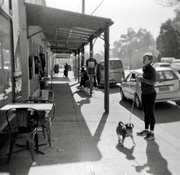brianentz
Member
I’m really enjoying my recent deep dive into rangefinder photography. But I wish I wasn’t so clueless regarding these and other terms regarding optical design. Any help?
That, and at least for myself, I find myself avoiding using the largest apertures on my fastest rangefinder lens because I struggle to nail critical focus when the lens is wide open. I realized late in the game that I'd be better off just buying the smaller, cheaper, and "slower" lenses to begin with.Price aside, there can be very good reasons for choosing a Skopar or Heliar over higher-line optics, such as smaller size and weight.
I only managed to see six reflections in a Bessa II Color Skopar. I'm perplexed why I'm not seeing the other two, to make a total of eight. Am I not holding the torch right? I only have the lens/shutter, I plan to fix it to an old folding camera for 70mm film if the 105mm Skopar covers it. I think it might, yet to see.
Oh ok, thanks. I just spotted the weak reflection after doing what you advised, but only had to remove the front glass.The weak reflection can be very hard to see.
Re y'r comment in post #9 above, the Color Skopar is a tessar type, not a triplet. The only lenses badged "Skopar" that aren't tessar types are Apo-Skopars. They are Heliar types.
That is, the nomenclature isn’t relevant to the craft.
It seems that way. In fact, a favorite picture of mine that I took last year, and it's not a good shot technically in terms of equipment being used, was taken with a bakelite camera sporting a single element lens. Also fixed focus and single speed. You can imaging what the image looked like, taken with such a cheap and basic camera. But the scene in the photo has so much real-life charm about it, I could never part with it. It's a street scene, with a few country folk, in an economically dying rural town not far from where I live. And us rural "hillbillies" inherently identify with each other, so the pic is a bit personal as well. All those positive photographic elements came together in a camera not conducive to any sort of quality, and the story in the photo meant more to me than the equipment used.
All those positive photographic elements came together in a camera not conducive to any sort of quality
I can believe it.I'll quote/paraphrase my late father on this issue.
"There have been more good photos taken with Instamatics than all the fancy 35mm SLRs combined."
It seems that way. In fact, a favorite picture of mine that I took last year, and it's not a good shot technically in terms of equipment being used, was taken with a bakelite camera sporting a single element lens. Also fixed focus and single speed. You can imagine what the image looked like, taken with such a cheap and basic camera. But the scene in the photo has so much real-life charm about it, I could never part with it. It's a street scene, with a few country folk, in an economically dying rural town not far from where I live. And us rural "hillbillies" inherently identify with each other, so the pic is a bit personal as well. All those positive photographic elements came together in a camera not conducive to any sort of quality, and the story in the photo meant more to me than the equipment used.
I'm reluctant to show it, our Fed Govt won't like what I said about the dying town, plus I have other reasons. It's not a photo I wish to make public, it's endearing to just me and the folk who live in my wider location. So I'll show another street scene I took on the second film I exposed in the same camera at a different time. Nothing in this pic was posed, just took the scene as it was.Show it to us!

I've tweaked your thread title to perhaps attract some further attention!
If you would like a book about this sort of thing, Rudolf Kingslake comes to mind: https://www.thriftbooks.com/w/lense...BsPBZlKEGMyXq0#edition=65578919&idiq=59327184
These are just trademarks, they aren't technical optical design terms. I think these trademarks mostly belong to Voigtlander. A couple of them are names for a particular lens design, for example a Heliar usually means a particular 5 element design, a Skopar is usually a Tessar type I think. Apo-Lanthar refers to a lens that was supposed to be better color corrected (more apochromatic) due to using glass with lanthanum as an ingredient. Nokton typically means fast lenses (noct- as in nocturnal, night). But you should realize that the terms date back as far as 1900 (original Heliar design) and they don't have a specific technical meaning. They only retain a meaning as long as the company holding the Voigtlander trademarks chooses to reserve Heliar for fancier lenses than Skopar, etc. http://camera-wiki.org/wiki/Heliar
| Photrio.com contains affiliate links to products. We may receive a commission for purchases made through these links. To read our full affiliate disclosure statement please click Here. |
PHOTRIO PARTNERS EQUALLY FUNDING OUR COMMUNITY:  |


